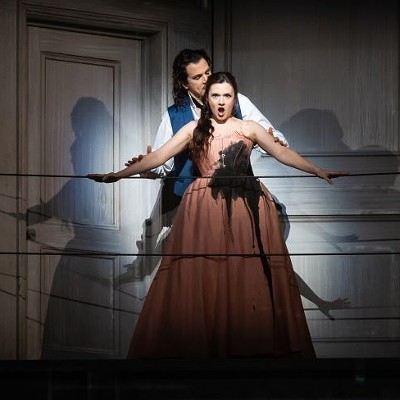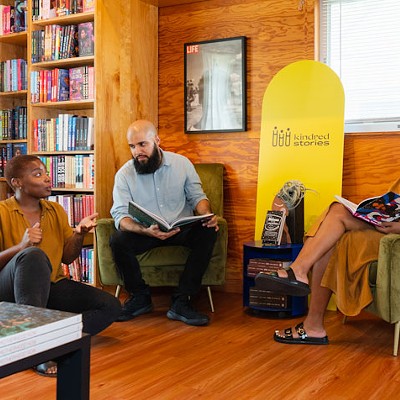This past Saturday was a busy one in Houston for the visual arts with up to a dozen galleries showing new work. The usual suspects were conspicuous on Colquitt Street's "Gallery Row." And we'll get there, but the day began at Project Row Houses with a group show "Round 34: Matter of Food" which, given PRH's community engagement and social justice motivations, turned out to be as much a potluck as it was an art show.
While seven of their row houses featured works by artists thinking about food traditions, composting, nutrition, and corporate control of our diets, the back yard was a busy place of families listening to music, playing games, and sampling local produce. By "local," I mean PRH has its own garden, and another flourishing community garden called Ecotone has been established about a block away, both in response to the area's "food desert," a problem that will be taken up by UH assistant professor of architecture Susan Rogers in the upcoming issue of Cite Magazine.
So what about the art?
Project Row Houses regularly plays host to art that promulgates direct political messages as much as it engages the aesthetic sensibility. Visitors should be ready to encounter a wide range of approaches to the central theme. At one end of the spectrum, "Spirit House" by Tamalyn Miller, presents art objects exhibited in space, as you might expect from any art gallery. She crochets clothesline and electrical cords into enormous doilies, which have an unexpected magical influence, protecting the house from evil. Miller's artworks are the exception in this show: the other projects are much more about involving the local community in ongoing processes, providing tools for living, and restoring traditions.
First of these, Texas Folk Life, an Austin organization, was on hand to recruit participants for its ambitious statewide survey called "A Place at the Table," which asks about food traditions you and I grew up with, hoping to show along the way, according to program coordinator Becky Bingman, that there's more to Texas food than just barbecue and tacos. Visitors sat down for half-hour interviews conducted by trained volunteers. Part of their effort is to collect enough stories to be able to show the sustainability and value of the survey, which continues to seek funding to expand its reach from central Texas and the Gulf Coast to the rest of the state.
In "Hearth House," a collaboration by Toni Tipton-Martin and Luanne Stovall, the visitor is invited to sit and share and to honor housekeeping traditions and the forgotten women who sustained them. Tipton-Martin is a scholar and journalist responsible for bring back into print the 1904 "Blue Grass Cook Book," the first book about African American hospitality that didn't denigrate its sources by making them into caricatures.
Photographs of turbaned black women from this book, printed on large mesh screens, are hung throughout the house. Tipton-Martin's stated aim to "break the Jemima Code," fits neatly into Stovall's Peace Through Pie project, in which she is hoping to make pie into the signal cuisine of Martin Luther King, Jr. Day, as well as promoting the "pie social" as a means to restore human understanding across social and political barriers. Stovall and Tipton-Martin are collecting pie recipes and stories, hosting monthly roundtable conversations at PRH to share kitchen tales, and will be organizing a Juneteenth pie social.
Jorge Rojas's "Gente de Maiz" house was also a highly interactive experience. Visitors were invited to sit down with Rojas who enacted a "Tortilla Oracle," a sort of maize divination. Several electric griddles in this house were turning out fresh tortillas, which heated up the entire clapboard building. Rojas had also built an altar and molded a congregation of human figures out of cornmeal, arranged like a mandala on the floor.
Michael Pribich's installation "Sugar Land" makes simple and large claims about the sugar industry, drawing attention to Houston's own Imperial Sugar Company as well as the entire industry's long history of exploitation and bloodshed. His most evocative piece comprises a stand of sugarcane held in and held up by a narrow handrail. The other installations seem like afterthoughts.
Both Tarsha M. Gary's and Tattfoo Tan's installations were in fact an exhibit of documentation of each of their efforts as they educate and inspire outside of any sanctioned art space. Tan promotes urban gardening, composting, and sustainable living through novel, and sometimes guerrilla, tactics. Gary is a noted Houston chef and educator whose installation - an elaborate display of fresh produce and a highly symbolic "tree of life" - was overshadowed by her actual cooking in the backyard. She was turning out a delicious hash of collards, sweet potatoes, and onions.
It takes just about 20 minutes to bike from Third Ward to Colquitt's Gallery Row, during which time it is necessary to completely readjust your expectations about artistic practice and reception. We put down the soul food and picked up the price lists.
At Moody Gallery, Michael Bise's large-scale pencil drawings were often startling transliterations of photographs that seemed to have been recovered out of a decades-old collection. Sometimes posed and sometimes candid, the images in "Blood Poisoning" are all made deeply intimate by the artist's careful lines and fluid shading. Even a picture of an apparent gunshot suicide in a car parked outside someone's house was touching in its particularity. A third-grade class portrait was the centerpiece of the show, a familiar arrangement of teacher and children on risers, the flag attendant, and two dozen individual and harried personalities on display, and not necessarily by consent.
McMurtrey Gallery had new works by Kate Breakey who recalls a time when the biological sciences were known as "natural history" and talented amateurs were responsible for collecting and recording their specimens. In "Painted Light," Breakey has adopted a process called "cyanotype," actually the very first photographic technique, in which an object is arranged on light-sensitive paper, casting a shadow or silhouette when exposed to light. Her subjects are snakes, birds, and rodents, sometimes posed as if in mid-stride, sometimes laid out formally as if for a portrait.
In fact, it seems that all of the subjects are dead, and these images are a sort of taxidermy, adopting similar strategies of pose and posture. The central image among the dozens that cover the wall (all in antique frames that reinforce the sense of remembrance and lost time) is of a coyote, apparently Breakey's first subject, recovered from the side of the road and appearing here to bay at the moon. Breakey's other works are still lifes and hyper-real close-up hand-colored gelatin-silver prints of birds and potted plants and flowers, sumptuous in their detail.
Finally, at Domy Books, collaborators Chad Hopper and Amanda Jones from Austin, were sharing the results of an ongoing practice of repurposing junk and cultural detritus in "Chisel Story Rust." What we find are plastic houseware mashups, schoolyard binder secrets, a lot of glue. As always at Domy, this show aims to delight, and its pleasures are in curio-sized surprises. Visitors to Austin April 16 and 17 may join Hopper and Jones for one of their regular "Junkyard Casseroles" a sort of swap meet (featuring live music, of course) that they host in their backyard, and from which they derive many of the raw materials for these works. Another source, according to Jones, is the nearby elementary school out of which lost homework assignments and secret love notes regularly take flight on the scudding breeze.





